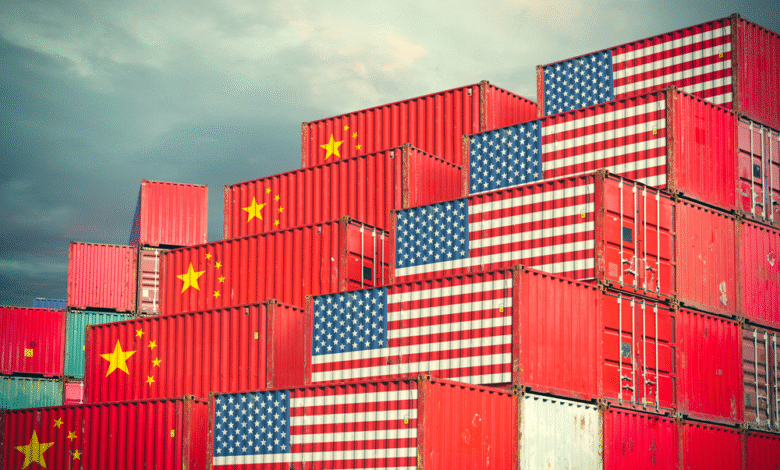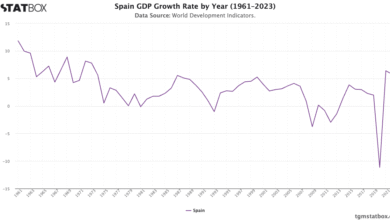China Shock: How It’s Cooling Inflation Globally

The term “China shock” is resurfacing as the world braces for the economic ripples from a surge of low-cost Chinese goods entering global markets. As the manufacturing powerhouse ramps up production, experts warn of the potential impact of cheap imports on the Southeast Asia economy, where local industries may face severe competition. However, amid rising concerns about inflation, this influx of affordable Chinese exports could actually ease price pressures for consumers, presenting a unique silver lining. As countries grapple with Asian inflation trends, the delicate balance between maintaining local production and benefiting from reduced costs will become increasingly critical. While some economies erect barriers against this wave of imports, others may find relief as inflation rates stabilize due to the availability of inexpensive goods.
As global markets watch the unfolding dynamics of the “China connection,” the implications of a renewed influx of Chinese commodities are stirring mixed reactions. The resurgence of affordable imports from China sparks debates about their effects on local manufacturing and inflation rates worldwide. Economists are keenly observing how these price trends might influence the strategies of central banks and policymakers in Southeast Asia and beyond. With many countries caught between the allure of low prices and the risk of economic stagnation, the conversation surrounding the ripple effects of Chinese exports is more relevant than ever. Understanding how the Asian economy adapts to these changes will be vital for navigating future trade relationships and inflationary pressures.
Understanding the China Shock
The term ‘China shock’ refers to the significant economic impact that high volumes of inexpensive Chinese imports can have on global markets. This phenomenon is not new; it echoes the historical events of the late 1990s and early 2000s when a vast influx of Chinese products contributed to decreased inflation levels worldwide. As countries like the US and those in Southeast Asia continue to grapple with the implications of rising Chinese exports, many are left assessing the balance between enjoying lower prices and protecting local industries from overwhelming competition.
As China ramps up its manufacturing output, nations are facing the challenge of adapting to an ever-changing economic landscape. The resulting cheap imports, while beneficial for consumers looking to stretch their budgets, put additional pressure on local producers. This presents a dilemma: on one hand, local economies benefit from reduced inflation rates owing to lower costs of goods; but on the other hand, local industries risk being sidelined in the face of such fierce competition. This ‘China shock’ serves as a reminder of how interconnected global economic systems are and the tensions that arise within them.
The Impact of Cheap Imports on the Southeast Asian Economy
Southeast Asia’s economy is feeling significant effects from the flow of Chinese exports. With many manufacturers in countries like Vietnam and Indonesia struggling against the onslaught of cheaper Chinese products, the region now faces a balancing act. On one hand, the availability of low-cost imports has provided much-needed relief for consumers suffering from rising living costs; however, it has simultaneously unleashed deep anxieties among local businesses that risk being undercut. As a result, governments throughout Southeast Asia are considering protective measures to shield their domestic industries.
The situation is intricate, as visitors to Southeast Asia may notice a rise in affordable items available for purchase, a direct result of cheap imports from China. Yet, these low prices could lead to long-lasting repercussions for local manufacturers, potentially jeopardizing jobs and economic stability. This delicate interplay of benefits and drawbacks illustrates the complex nature of globalization, where countries must navigate between the advantageous pricing of imports and the necessity of fostering a robust local economy. Tracking Asian inflation trends as they respond to these dynamics will be essential as economies work to adapt.
Inflation Trends and Economic Adaptations
Current inflation trends across Asia show a fascinating interplay where the economic policies of individual nations are influenced by the prices of imported goods. As countries like Singapore see disinflationary effects due to China’s cheap exports, central banks need to carefully consider their monetary policy responses to ensure they can curb inflation effectively. For example, predictions suggest easing for countries in the ASEAN bloc as they respond to the influx of low-cost goods, potentially leading to a divergence in economic paths from nations like the U.S., which may still be grappling with inflationary pressures.
Adaptation in the face of shifting economic tides is crucial for Southeast Asian countries. Policymakers are actively engaging in discussions about how best to harness the benefits of cheaper imports while mitigating the potential harm to domestic production. Strategies include fostering innovation and improving competitiveness among local industries. Economic resilience will require nuanced strategies, balancing the dual imperatives of maintaining growth and managing inflation effectively amidst the backdrop of a new ‘China shock’ that continues to change the landscape.
Prospective Rate Cuts in Response to Inflationary Changes
In reaction to the evolving economic climate influenced by the recent ‘China shock,’ many Asian economies are toggling their interest rates strategically. As economists forecast a potential reduction in inflation due to influxes of affordable Chinese imports, many central banks, such as those in India and Australia, may consider launching a series of rate cuts. This proactive approach is aimed at stimulating economic growth and encouraging consumer spending in an environment characterized by uncertainty. In this way, central banks are playing a dynamic role in adjusting their policies to mitigate the challenges posed by inflation.
Such scenarios highlight the importance of closely monitoring Asian inflation trends and subsequent responses by financial institutions. Lowering interest rates can aid struggling local economies by fostering investment and making borrowing cheaper, but this approach must be pursued cautiously. The risk of overshooting could lead to adverse effects if inflation unexpectedly spikes or becomes volatile due to external shocks. Thus, the conversations around these monetary policies are deeply intertwined with the outcomes of Chinese exports and the resulting economic shifts, reinforcing the necessity for coordinated actions across the region.
How Chinese Exports Influence Global Markets
Chinese exports are a powerful force in shaping global market dynamics, particularly for economies in Southeast Asia. As millions of containers filled with goods flow from China’s factories to markets around the world, various sectors in recipient countries face not only opportunities for cost reductions but also pressures to adapt their manufacturing practices. The interplay between cheap imports and local production can lead to substantial shifts in market pricing, labor dynamics, and trade relationships.
Moreover, the implications of these changes resonate through the supply chains, influencing everything from raw materials to finished goods. Countries reliant on specific products from China must remain vigilant about fluctuations in availability and prices, which can lead to broader economic consequences if local supply chains cannot keep pace with changing demands. By closely monitoring the impact of Chinese exports on inflation and the economy at large, policymakers can better strategize and prioritize actions that foster sustainable growth and stability.
Protective Measures: Balancing Local Interests and Global Trade
As the ‘China shock’ prompts concern among countries experiencing increased competition from inexpensive imports, many governments are taking a closer look at protective measures. These measures can range from imposing tariffs to bolstering regulations aimed at safeguarding local manufacturing jobs. Countries like India, Indonesia, and Vietnam are already implementing various strategies in a bid to mitigate the impact of overwhelming Chinese exports, creating a patchwork of trade policies that reflect their unique economic challenges.
The balancing act between maintaining global trade relationships and protecting local industries is a complex issue. While tariffs on imports can support domestic markets, they may also lead to retaliatory measures from trading partners, resulting in potential trade wars. Policymakers must navigate these waters carefully to ensure that they do not inadvertently provoke instability while striving for economic improvement. Adapting to the realities of the globalized marketplace requires agile policymaking that harmonizes the need for local protection with the benefits of international trade.
Consumer Benefits from Low-Cost Chinese Goods
One of the clearest advantages of the recent influx of Chinese exports is the creation of a more consumer-friendly market environment. With many goods available at significantly reduced prices due to Chinese manufacturing scaling up, consumers across Asia benefit from lower retail costs on essential and discretionary items alike. This decrease in prices can be seen as a direct response to competitive pressures, which ultimately benefit end-users trying to manage their budgets amid rising living costs.
However, it is vital to recognize the broader implications of this phenomenon as well. While consumers enjoy the immediate benefits of lower prices, this situation can lead to behaviors that favor imported goods over locally produced alternatives. A reliance on cheaper imports could stymie domestic industries, threatening job security and economic health long-term. Therefore, while the consumer appears to gain in the short term, the sector’s future sustainability hinges on finding a way to balance these imported goods with support for local production and craftsmanship.
Long-Term Economic Forecasts: Effects of Chinese Exports
Looking ahead, the economic forecasts in response to continued Chinese exports paint a complex picture. On one hand, countries could find themselves reaping the benefits of sustained lower inflation, supporting consumer spending and potentially enhancing economic growth. On the other hand, local industries risk facing long-term challenges as they compete with the power of substantial Chinese production capacities, which may lead to structural changes in various markets. As these dynamics evolve, policymakers must keep a keen eye on the broader economic landscape.
Analysts and economists will likely focus on examining not only the immediate effects of the current ‘China shock’ but also anticipating what ripple effects might emerge in the coming years. Wealth disparities within nations may widen if manufacturing jobs in local industries diminish, while consumer price advantages remain a double-edged sword. Drawing on historical data and current trends will be crucial for devising effective economic strategies that prioritize long-term stability without sacrificing local industrial capacity.
Frequently Asked Questions
What is the ‘China shock’ and how does it affect inflation in Asian economies?
The ‘China shock’ refers to the influx of low-cost Chinese imports into global markets, significantly impacting inflation rates. Economists suggest that as Chinese goods flood economies, they help reduce living costs, offering a potential relief from inflation pressures in countries like Singapore and Australia.
How are cheap Chinese exports influencing Asian inflation trends?
Cheap Chinese exports are contributing to Asian inflation trends by lowering consumer prices in the region. Countries experiencing cheaper imports from China can enjoy reduced inflation rates, providing central banks with the space to implement monetary easing, especially in light of rising living costs.
What impact do cheap imports from China have on the Southeast Asia economy?
The impact of cheap imports from China on the Southeast Asia economy is twofold. While these imports can stimulate consumer spending by lowering costs, they also pose a threat to local industries, leading some governments to impose protective measures to shield domestic production from aggressive price competition.
Are the effects of the ‘China shock’ similar to those from past episodes of inexpensive Chinese goods?
Yes, the current ‘China shock’ is reminiscent of past episodes where a surge in inexpensive Chinese goods kept inflation low but negatively impacted local manufacturing jobs. Countries are once again faced with weighing the benefits of cheaper imports against the potential detriment to their local economies.
How might the ‘China shock’ influence the monetary policies of central banks in Asia?
The ‘China shock’ may lead central banks in Asia to adopt looser monetary policies due to lower inflationary pressures caused by an influx of cheap imports. As countries experience dwindling inflation rates, such as in Thailand and the Philippines, there may be further rate cuts to stimulate growth amidst challenging economic conditions.
| Key Point | Details | |
|---|---|---|
| Increase in Chinese Manufacturing | China’s manufacturing is increasing, leading to lower costs of imports globally. | |
| Impact on Local Industries | Asian economies express concern over cheap imports affecting local businesses. | |
| Inflationary Impact | Lower prices from Chinese goods may help curb inflation in various economies. | |
| Economic Forecasts | Nomura predicts rate cuts from central banks in Asia due to lower inflation pressures. | |
| Historical Context | A similar situation occurred in the late 1990s, termed the ‘China shock’, affecting jobs and inflation. | |
| Protectionist Measures | Countries like India and Vietnam have taken actions to protect local production from Chinese imports. | |
| Disinflation Across Asia | Economists expect a widespread impact of low-cost Chinese imports leading to disinflation throughout Asia. | |
Summary
The looming ‘China shock’ presents both challenges and opportunities for global economies. As lower-cost Chinese goods flood international markets, nations must navigate the balance between inflation control and the potential threat to local industries. This economic phenomenon, reminiscent of past shocks, could pave the way for improved consumer prices while igniting necessary measures to support domestic manufacturing.



